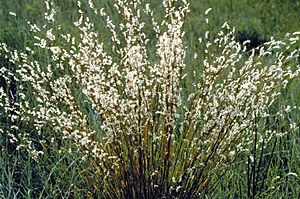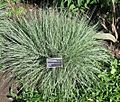Little bluestem facts for kids
Quick facts for kids Little bluestem |
|
|---|---|
 |
|
| Mature seed heads | |
| Scientific classification | |
| Genus: |
Schizachyrium
|
| Species: |
scoparium
|
| Synonyms | |
|
Andropogon scoparius Michx. |
|
Schizachyrium scoparium, often called little bluestem or beard grass, is a type of grass found in North America. It grows naturally in most parts of the United States, except for California, Nevada, and Oregon. You can also find it in a small area of Canada and northern Mexico. It is very common in the prairies of the Midwestern United States.
Little bluestem is a perennial bunchgrass. This means it grows back every year and forms clumps. It is an important part of tallgrass prairies. Other famous grasses found there include big bluestem, indiangrass (Sorghastrum nutans), and switchgrass (Panicum virgatum). It is a "warm-season" grass. This means it grows best when the weather is warm. It uses a special way to make food from sunlight, called C4 photosynthesis.
Description
Little bluestem grows into an upright, round clump. Its leaves are soft and can be bluish-green or grayish-green. In May and June, it usually reaches about two to three feet (60-90 cm) tall. Around July, it starts to grow flower stalks. These stalks can reach four to five feet (1.2-1.5 meters) high.
In the fall, little bluestem changes color. It turns a beautiful coppery or orange color. You might also see hints of red or purple. In some places, like sandy soils, it can look even redder. During winter, it becomes more of an orangish-bronze color. It stays this way until early spring, when it turns tan.
Cultivation
People often grow little bluestem in gardens. It is good for many different climates, from USDA zones 3 to 10. This means it can handle cold winters and hot summers.
This plant grows best in full sunlight. It also needs soil that drains water well. You can dig up and divide the plant in spring. This helps it grow more, or makes an old, big plant smaller. Like many American prairie grasses, such as big bluestem, indiangrass, and switchgrass, it can be burned. This is done in late winter or early spring before new growth appears. The grass burns quickly and cleanly.
Cultivars
Plant growers have created different types of little bluestem. These are called cultivars.
- 'Carousel' is a smaller type. It has especially pretty fall colors.
- 'The Blues' is a type chosen for its bluer leaves.
- 'Standing Ovation' grows very straight and upright. It has bluer, thicker leaves and stronger stems.
Subdivisions
One special type of little bluestem is called var. littorale. This variety grows along the eastern and southern coasts of the United States. It is also found along the shores of the Great Lakes. This type is good at growing in sand dunes. Some people even think it is a separate species, called S. littorale.
Culture
Little bluestem is an important grass in some states. It is the official state grass of both Nebraska and Kansas.
Ecology
Little bluestem is very good at handling dry weather. It is also a host plant for several types of butterflies and skippers. This means that the caterpillars of these insects eat the leaves of little bluestem. Some of these include the cobweb skipper, common wood nymph, crossline skipper, Dakota skipper, dusted skipper, Indian skipper, Leonard's skipper, Ottoe skipper, and swarthy skipper.
Images for kids
See also
 In Spanish: Schizachyrium scoparium para niños
In Spanish: Schizachyrium scoparium para niños




